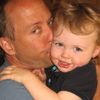Like a lot of kids, my daughter Natalie used to be afraid of monsters. We had a little routine every night. I checked under the bed. My wife Jackie cleared the closet. We would turn on a nightlight, read her a story and inevitably fall asleep snuggled up with her, safe once again from the torments of scary monsters.
Today, Natalie is no longer concerned with pretend monsters because she learned -- in the worst way imaginable -- about the real threats to our families and communities.
Two years ago Natalie's little brother Daniel was one of twenty first grade children who, along with six brave educators, were killed during the devastating mass-shooting at Sandy Hook Elementary School in Newtown, Connecticut.
Daniel was killed by a deeply disturbed individual. The shooter had unfettered access to high-powered firearms. His behavior -- particularly his obsession with violence and school shootings -- displayed all the warning signs of a ticking time bomb. These are the conditions that combine to create a monster -- not the fake kind that scares children, but a real one who kills them.
Now instead of monsters, Natalie is afraid of loud noises, dark places and unknown people. How can I keep her safe from a threat she knows is real?
Parents are good at talking to our kids about the made-up threats. It's easy to keep them safe from things that do not exist. Talking about the real threats and keeping them safe from real dangers is much harder and we should be doing so much more.
Are we talking to our kids about saying something to an adult if they hear, see or read about a potential act of gun violence? We should be, because an analysis of school shootings reveals that four out of five times the attacker told at least one person about their plans ahead of time. All over the country, we are seeing evidence that young people speaking up about threats they find on Instagram and Twitter can help school officials and police identify and stop violent plans before they take lives.
At home, are we protecting our children from gun tragedies through safe storage, modeling responsible gun ownership and teaching young people what to do if they encounter a gun? We should be, because right now more than two million children are living in a home with a firearm that is both loaded and unlocked.
At school and in our communities are we doing everything we can to look for the early warning signs in individuals who may pose a risk to themselves or others? Are we reaching out with compassion to those who are isolated, excluded or may be suffering from mental illness? We should be, because studies consistently show, at least 90% of the time, people who die by suicide are suffering with a mental disorder.
Just as deadly tragedies like the one that took our sweet little Daniel -- or the 95 school shootings since Sandy Hook -- devastate entire communities, it will take community-based solutions to prevent them. By working together as families, schools and communities, we can promote common sense tools we know will help reduce the causes of gun violence.
If we address the real threats, then maybe kids like Natalie will only have to worry about monsters under the bed.
